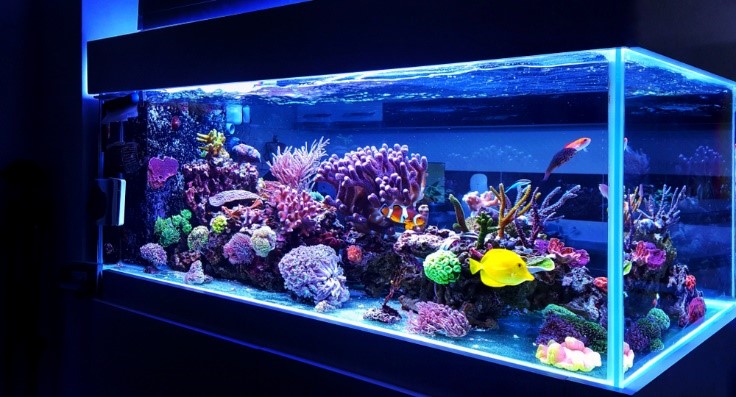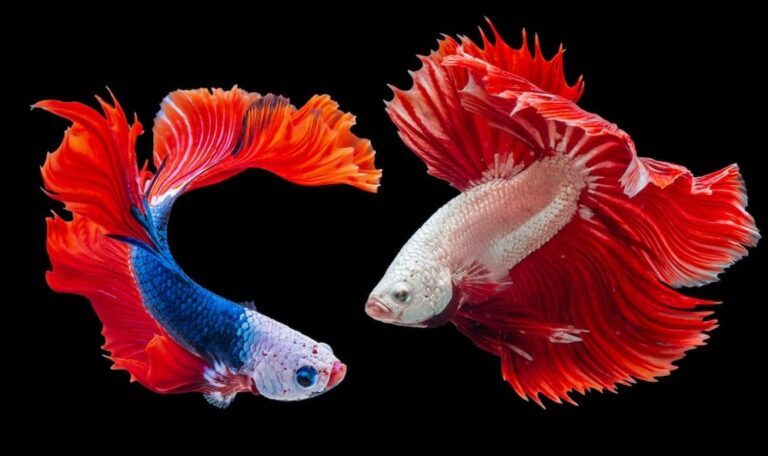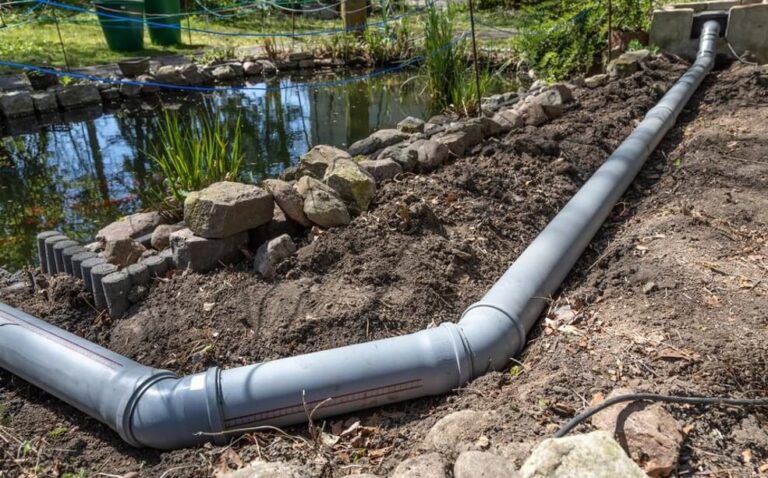One of the key decisions you have to make when buying an aquarium is whether to buy a saltwater or freshwater tank. Each type of aquarium is suitable for different types of fish and has varying associated costs and maintenance requirements.
Freshwater aquariums are designed for keeping freshwater fish. These species are often found in lakes and rivers. They can also be used to keep freshwater invertebrates, such as snails and shrimps. On the other hand, saltwater tanks keep fish species found in the ocean and other salt-tolerant marine species. They have a high level of sodium content.

Generally, saltwater aquariums are more difficult to maintain as you need to keep water parameters such as salinity and temperature within a given range. On the other hand, freshwater fish are hardier.
This article will discuss in detail the difference between saltwater and freshwater aquarium and the pros and cons of each.
Saltwater vs Freshwater Aquarium Differences
Costs and Components
Saltwater aquariums cost more than freshwater aquariums, both in terms of the initial buying cost and overall maintenance. On average, it costs twice as much to set up and maintain a saltwater aquarium as a freshwater aquarium.
A saltwater aquarium has more components. It has the standard components that are also found in freshwater fish, including a filter, sand/ gravel substrate, lighting unit, thermometer, heater, and saltwater testing kits. However, it requires additional components such as powerheads, air pumps, protein skimmers, liverock, and marine salt.
The most expensive components of a saltwater aquarium include a protein skimmer which costs about $150, live rock at $100, and a water testing kit at about $70. Saltwater fish are also more expensive—about $20 or more per fish.
A saltwater fish aquarium is typically stronger than a freshwater one. A larger fish tank is recommended for a saltwater tank—a minimum of 30 gallons. The larger the tank, the easier it is to maintain the various parameters, but the more expensive it is to buy and maintain the tank.
On the other hand, freshwater aquariums require the following components: lighting, decorations, filter, and tank. They do not need a protein skimmer and live rocks, which are the most expensive components in a saltwater aquarium.
A heater is required for tropical fish. Maintenance costs include testing kits, water conditioners, food, and electricity. The fish are easily available in pet stores and cost around $5-$10 per fish.
Electricity consumption is fairly comparable for saltwater and freshwater fish. It depends on the size and power rating of the aquarium.
Type of Fish
The two types of tanks also vary by the type of fish that can be kept. Saltwater fish are more colorful than freshwater fish. You can incorporate a variety of saltwater fish for a vibrant-looking saltwater aquarium.
Examples of saltwater fish include green chromis, cardinal fish, hamlets, clownfish, anthias, tangs, hogfish, rabbitfish, sea horses, dwarf angelfish, clownfish, etc.
You can also incorporate coral reefs and anemones. As such, saltwater aquariums are also referred to as reef aquariums. Saltwater fish are more difficult to come by as it is difficult for them to breed in captivity. Therefore, most sellers have to source in the wild.
On the other hand, freshwater fish are less vibrant, although you can opt for more colorful fish species for your aquarium. The most popular freshwater fish to keep in an aquarium include betta fish/siamese fighting fish, goldfish, cichlids, tetras, mollies, guppies, danios, swordtails, koi, etc. You can also incorporate live plants and invertebrates such as snails, crabs, and shrimps.
Maintenance
The main goal of maintenance is to replicate the water condition in the natural habitats of the fish and keep the various parameters within the recommended range. Typically, the marine environment is more stable than lakes, rivers, and ponds.
The water pH and salinity are constant. On the other hand, water conditions in lakes and rivers are constantly changing. So, freshwater fish are hardier. As such, a saltwater aquarium requires careful maintenance.
How to Maintain a Saltwater Aquarium
Saltwater tanks require daily, weekly, biweekly, and monthly maintenance. The exact procedure for maintaining a saltwater tank depends on whether you have fish only, fish with live rock, or fish and reef in the tank. It is easier to maintain a fish-only tank.
Daily maintenance entails checking water salinity and temperatures and topping off the water. This is because, even if the fish tank is tightly sealed, some water evaporates, especially if the tank is heated.
The salt becomes more concentrated, offsetting the recommended salinity levels. Therefore, you need to top off the tank with heated freshwater. Use a refractometer or a hydrometer to ensure that the salinity levels are within the recommended range for the marine fish in the aquarium.
It is also important to check water temperatures daily, especially for tropical marine fish. A drop in temperature will cause the fish to get sick and die. Invest in a high-quality submerged thermometer. Also, check that the heaters are working properly.
For weekly maintenance, clean the fish tank glass or acrylic walls using a magnetic algae scraper, then top off the tank with freshwater. This step is particularly important if your fish tank has coral reefs. Coral reefs need stronger lighting to thrive, which also causes algae to grow faster. Therefore, scrubbing the algae weekly prevents build-up and improves water quality.
The biweekly maintenance involves water exchange and testing the various water parameters, e.g., ammonia, nitrate, nitrite, and pH. The recommended pH and water hardness level for most saltwater fish is 7.8-8.5 and 8-12dKH, respectively.
You should replace 10-20% of the water. Use a sand or gravel siphon to exchange water in the deeper layers of the substrate. Inspect the filter media to ensure that water flows freely and there is no stuck debris.
For the monthly maintenance, clean the filter, heaters, pumps, and sand bed. Vacuum the substrate to remove any debris. Be careful when vacuuming to avoid disturbing any bottom-dwelling fish or sucking them into the vacuum cleaner. Also, replace the filter media and change the water.
How to Maintain a Freshwater Aquarium
Similar to saltwater aquarium maintenance, there are daily, weekly, bi-weekly, and monthly tasks for freshwater aquariums.
Daily maintenance involves checking that the pumps, filters, and lights are working properly. Then remove any leftover foods and top off the tank with conditioned water. Also, check the water temperature to ensure it is within the recommended range for the fish in the tank. Monitor pH, ammonia, and nitrate levels in the water. You can incorporate live plants in the fish tank to help with fish waste management.
Change the water and clean the tank every one to two weeks, depending on the tank size and the number of fish therein. The more fish in the tank, the more waste they produce. Therefore, you will need to change the water more frequently—preferably every week. Change 25% of the water in the fish tank.
Clean the tank every month. Vacuum the substrate, use an algae scrubber to clean off any algae built up on the glass or acrylic walls, and use a filter brush to clean any debris that may have accumulated.
If the aquarium has live plants, use scissors to prune them and add an aquarium fertilizer. Work around the fish when cleaning and changing water to avoid disturbing them.
Saltwater vs Freshwater Aquarium Pros and Cons
Now, let’s take a look at the pros and cons when debating saltwater vs freshwater aquariums.
Saltwater Aquarium

Pros
- Wide range of colorful fish
- You can incorporate coral reefs in the tank setup
Cons
- Not suitable for beginners
- Saltwater fish are more expensive to buy
- Tank setup and maintenance require more specialized equipment
- You require a larger tank—at least 30 gallons
- Larger tanks should be set up in a purpose-built stand. Consequently, they take up more space in your home
- Marine water tanks require more intricate care and maintenance
- Most saltwater fish are territorial and aggressive, making it difficult to keep them in a community or school
- Saltwater fish have a higher mortality rate than freshwater fish
- Saltwater tanks are more prone to algae growth
Freshwater Aquarium

Pros
- Freshwater fish and aquariums are beginner and kid-friendly
- Easier and cheaper to set up and maintain
- You can start with a 5-gallon fish tank for nano fish, e.g., betta fish tank
- You can keep fish in communities or schools
- Freshwater fish have relatively longer mortality
- You can incorporate plants in the tank setup—they improve oxygen levels, break down nitrates, control algae, and enhance aesthetics
Cons
- Freshwater fish are not as colorful as marine species
- Requires frequent water testing
- Freshwater fish are more prone to diseases
Why Do You Require a Bigger Saltwater Aquarium?
Salt water has a lower capacity for oxygen than freshwater. Therefore, a larger tank provides a wider surface area for optimal gaseous exchange. Also, you can’t keep live plants in a saltwater tank to eliminate nitrates.
Therefore, the waste products build up and get concentrated faster in a smaller tank. Furthermore, saltwater fish are generally bigger than most freshwater fish, so you require a bigger tank to enable them to move around.
Can You Use a Saltwater Aquarium for Freshwater Fish?
Yes, you can, with a few adjustments to the tank. First, drain the tank and remove all the equipment. Then clean it thoroughly with dechlorinated water ensuring you remove any accumulated salt. Remove the live rock and protein skimmer.
Put back the other components, including sand or gravel substrate, lighting, filters, heater, air pump, and decoration. Fill the tank with dechlorinated water. Set the right parameters for the type of freshwater fish you will keep. Wait 24-48 hours for the water parameters to stabilize before adding the fish.
Conclusion
Freshwater aquariums have low salinity levels and are suitable for freshwater fish often found in lakes and rivers. They use dechlorinated water and do not require added salt. On the other hand, saltwater aquariums have high salinity levels and are best suited for freshwater fish species typically found in the ocean.
You can easily tell apart the two types of aquariums at a glance. Saltwater fish are more colorful, have brighter lighting, and may have coral reefs. On the other hand, freshwater aquariums use standard fluorescent lights, which are dimmer. They may have nano fish or larger fish and some plants.
Freshwater aquariums are a more popular option for beginners. They are cheaper to buy and easier to maintain. Besides, freshwater fish are easier to keep and more forgiving to fluctuations in the water parameters. Conversely, saltwater aquariums are costlier to buy and maintain. They are best suited for intermediate and advanced aquarists.
Each type of fish tank has pros and cons, making it suitable under specific conditions. If you are an experienced aquarist willing to pay more for your fish, aquarium, and maintenance, go for a saltwater reef aquarium. On the other hand, if you are a beginner, go for a freshwater aquarium.






